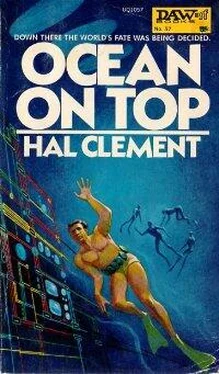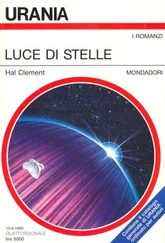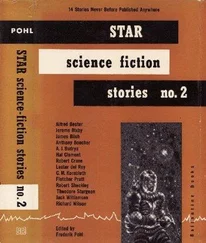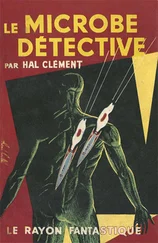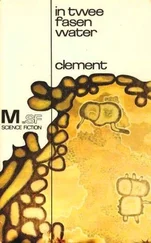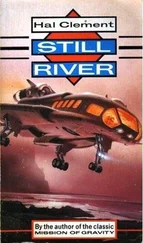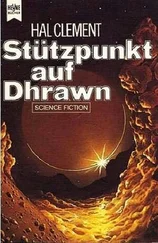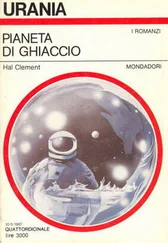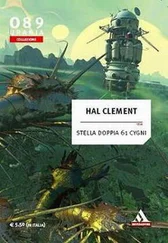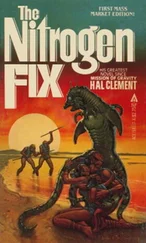Hal Clement - Ocean on Top
Здесь есть возможность читать онлайн «Hal Clement - Ocean on Top» весь текст электронной книги совершенно бесплатно (целиком полную версию без сокращений). В некоторых случаях можно слушать аудио, скачать через торрент в формате fb2 и присутствует краткое содержание. Год выпуска: 1973, Издательство: DAW Books, Жанр: Фантастика и фэнтези, на английском языке. Описание произведения, (предисловие) а так же отзывы посетителей доступны на портале библиотеки ЛибКат.
- Название:Ocean on Top
- Автор:
- Издательство:DAW Books
- Жанр:
- Год:1973
- ISBN:нет данных
- Рейтинг книги:5 / 5. Голосов: 1
-
Избранное:Добавить в избранное
- Отзывы:
-
Ваша оценка:
- 100
- 1
- 2
- 3
- 4
- 5
Ocean on Top: краткое содержание, описание и аннотация
Предлагаем к чтению аннотацию, описание, краткое содержание или предисловие (зависит от того, что написал сам автор книги «Ocean on Top»). Если вы не нашли необходимую информацию о книге — напишите в комментариях, мы постараемся отыскать её.
Ocean on Top — читать онлайн бесплатно полную книгу (весь текст) целиком
Ниже представлен текст книги, разбитый по страницам. Система сохранения места последней прочитанной страницы, позволяет с удобством читать онлайн бесплатно книгу «Ocean on Top», без необходимости каждый раз заново искать на чём Вы остановились. Поставьте закладку, и сможете в любой момент перейти на страницу, на которой закончили чтение.
Интервал:
Закладка:
Some of my friends have shown a tendency to solve problems by doing nothing until the last possible moment. I’ve outlived most of them. Once I’d noticed the tumbling, it took me about five seconds to run through the possible actions. I could cut loose from the wreckage right now, exposing the nearly spherical form of the tank to anyone who was watching with a good sonar — though no one had been so far. I could turn on the lights so as to see the bottom before I hit and, hopefully, still separate in time if it proved necessary; that would also be inconsistent with the concealment plan. I could sit and hope I would land in the right attitude in spite of the tumbling — that is, do nothing. That might mean that I would have to argue for my life with the laws of nature, which are harder to convince than most human opponents.
The first two choices meant — well, maybe Bert and Joey and Marie were still alive. I reached for the light switch.
I didn’t touch it, though. All of a sudden I could see the bottom anyway.
At least, it looked as though it ought to be the bottom. It was in the right direction — I could still tell up from down — and it seemed flat. And it was visible.
Chapter Two
I didn’t believe it, of course. I’m a very conservative person who likes even his fiction realistic, and this was too much to swallow. I had to stop reading The Maracot Deep when I was young because it described a luminous ocean bottom. I know Conan Doyle had never been down and needed the light for story purposes and didn’t have very high standards of consistency anyway, but it still bothered me. I knew he was wrong for the same reason everyone does — the bottom just isn’t bright.
Only now it was.
The tumbling wreck was swinging me upward away from the light, and I had time to decide whether I should believe my eyes or not. I could still read instruments. The pressure dial gave a direct depth of four thousand eight hundred eighty feet; a quick mental correction from the record tape of the thermograph added another two hundred or so. I certainly should be near the bottom, somewhere on the northern slopes of the mountain whose peaks are Rapanui.
I swung gently over the top and back down the other side, and my line of sight pointed downward again. Whether I wanted to believe my eyes or not, they insisted there was light in that direction. It was a gentle yellow-green glow — just the sort of thing you use in lighting effects to give the impression of an underwater scene. At first it looked uniform and smooth; then, a few turns later and two hundred feet lower, it showed a pattern. The pattern was of squares, with their corners just a little brighter than the rest of the area. It didn’t cover the whole bottom; its edge was almost below me, and it extended toward what I thought was the north, though my compass wasn’t reacting too well to the tumbling.
In the other direction was the normal comforting and frightening darkness — that was real enough.
Two things happened at almost the same instant. It became evident that I was going to come down pretty close to the edge of the light area, and it also became obvious what the light area was. The second realization got to me. For three or four seconds I was so furious and disgusted that I couldn’t plan, and as a result I almost didn’t get around to telling this story.
The light was artificial. Believe it if you can.
I realize that for a normal person it’s hard. Wasting watts to light up the outdoors is bad enough, but sometimes it’s a sad necessity. Spending power to illuminate the sea bottom, though — well, as I say, for a few moments I was too furious to think straight. My job has brought me into contact with people who were careless with energy, with people who stole it, and even with people who misused it; but this was a brand-new dimension! I was lower now and could see acres and acres of light stretching off to the north, east, and west until it blurred out of sight. Acres and acres lighted by things suspended a few yards above the level bottom, things visible only as black specks in the center of slightly brighter areas. At least, whoever was responsible for this display had some sense of economy; he was using reflectors.
Then I got my anger under control, or maybe my fear did it for me. I suddenly realized that I was only a few dozen yards above the lights. I was not going to come down among them, but a little to the south. I couldn’t say safely to the south. I couldn’t say safely anything, because my assemblage of Pugnose-bow and safety tank was turning over slowly enough to let me predict the attitude it would have when it hit bottom, and it looked pretty certain that the open end of the hull would be underneath.
Quite aside from the fact that I wouldn’t be able to see anything from under the wreckage, there was the likelihood that I wouldn’t be able to do anything either — such as get back to the surface. This time I did reach the controls.
Since the whole idea hinged on concealment, the separators used springs rather than squibs. I waited until the spin put the hulk between me and the light and punched the button. The push was light enough to make me wonder for a few seconds whether I mightn’t be in even worse trouble than I’d supposed. Then light began to come in through ports which had been covered by the hull, and that worry ended. The springs had kicked the tank away from the lighted region, so I could see Pugnose’s bow outlined against the luminescence. The separation had slowed our fall very slightly with the wreckage now going just a trifle faster than I was. At least something was going as planned; the wreck would hit first, so there should be no chance of my getting trapped under it.
I hadn’t expected to see it hit bottom, of course. I would certainly never have expected to see what happened when it did.
For the most part, level stretches of sea bottom tend to be on the gooey side. They may call it globigerina ooze or radiolarian ooze, but it’s usually ooze. You can meet with coral and sand and other firm stuff in shallow water and honest rock at times on slopes, but where it’s level you expect something like a cross between ordinary mud and the top couple of inches of a stagnant pond. When something hard and heavy lands on it, even gently, you don’t expect the bottom to give it much support. You may sometimes be surprised on this matter, but you never count on anything bouncing off the sea bottom.
Pugnose didn’t exactly bounce, I have to admit, but she certainly didn’t behave properly. She hit the lighted surface thirty or forty yards from the edge, and perhaps twice as far from me. I could see easily. She touched, as expected, and sank in as expected. There was no swirl of silt, though — no sign of the slow-motion splash you normally see when something lands in the ooze. Instead, the bow section disappeared almost completely into the smooth surface while a circular ripple grew around it and spread away from the point of impact. Then the wreckage eased gently back up until it was half uncovered, then back down again, still in slow motion. It oscillated that way three or four times before coming to rest, and each rebound sent another ripple spreading out from the spot for a dozen yards or so.
By the time that stopped, so had my tank. I felt it hit something hard — rock, for a bet, and I’d have won. Then it began to roll very, very gently toward the light. I couldn’t see the surface I was on at all clearly, but it seemed evident that it was a solid slope which would deliver me beside the Pugnose in two or three minutes if I didn’t do something about it. Fortunately, there was something I could do.
The tank had what we’d come to call legs, six-foot-long telescoping rods of metal which could be extended by springs and retracted again by solenoids. I was still hoping not to have to use magnets, but it seemed that the legs were in order; I propped out four of them in what I hoped were reasonable directions. Enough of the guesses were right to stop the rolling, and for the first time I had a steady observing platform. Naturally, I concentrated on the area I could see.
Читать дальшеИнтервал:
Закладка:
Похожие книги на «Ocean on Top»
Представляем Вашему вниманию похожие книги на «Ocean on Top» списком для выбора. Мы отобрали схожую по названию и смыслу литературу в надежде предоставить читателям больше вариантов отыскать новые, интересные, ещё непрочитанные произведения.
Обсуждение, отзывы о книге «Ocean on Top» и просто собственные мнения читателей. Оставьте ваши комментарии, напишите, что Вы думаете о произведении, его смысле или главных героях. Укажите что конкретно понравилось, а что нет, и почему Вы так считаете.
